Blog
May 30th, 2016
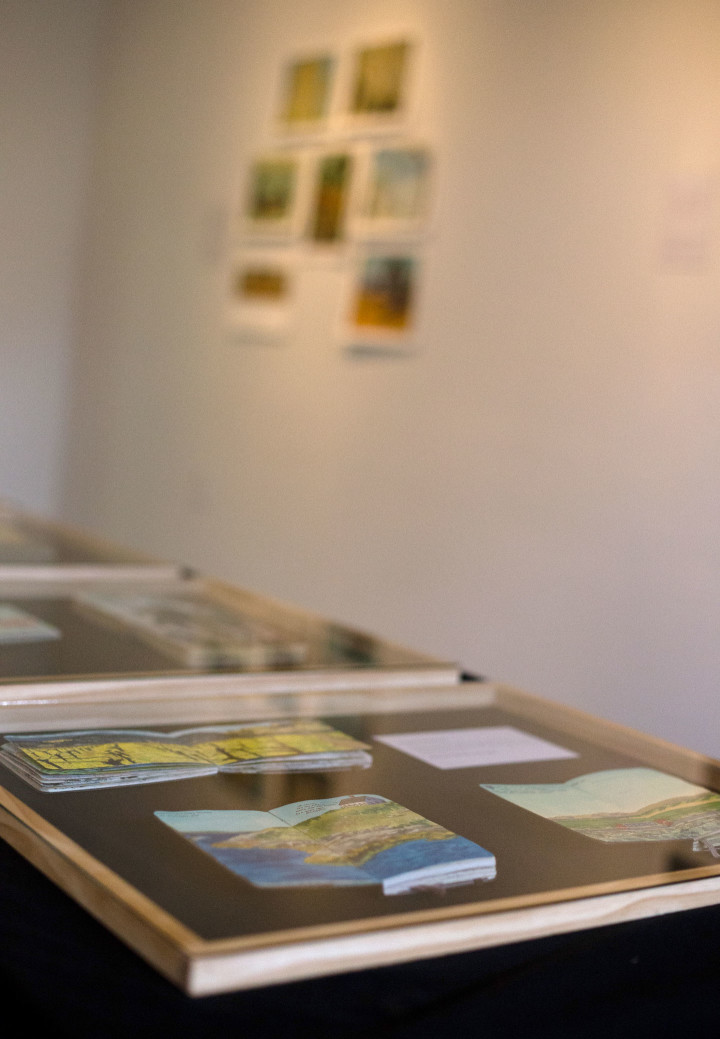
Photo by Shawn H. Nichols, taken at Artist Trust on Tour: Tacoma
If you happen to be in or passing through Tacoma soon, I’ve got a new show of sketchbook drawings up right now, at the brand new Feast Arts Center on Hilltop.
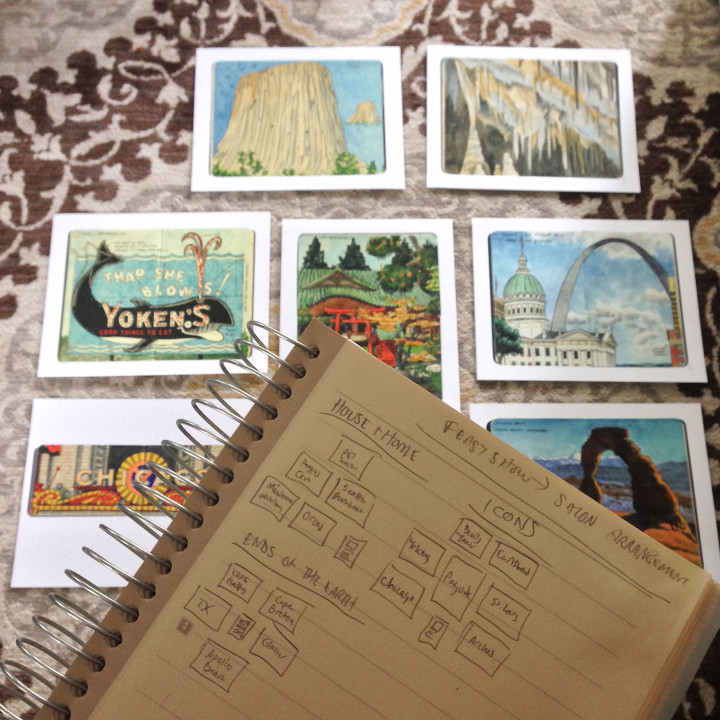
Like the way I do it on my travel blog, the images in the exhibit are arranged thematically rather than chronologically—this made curating the show something of a challenge, since I have frillions of drawings to choose from. So I did a practice run on my living room floor, with a notebook in hand to jot everything down (seems fitting!).
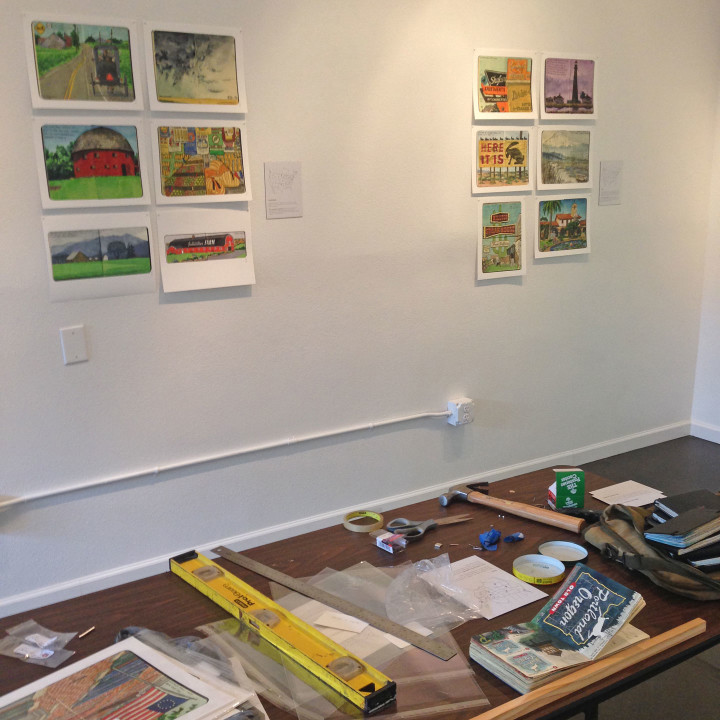
That ended up being a really good idea, because pre-arranging everything beforehand made the installation of the show much, much easier. All I had to do was measure and level everything, rather than try to make any aesthetic decisions on the fly. Still, you can see from the above photo that hanging a show is always a big, big mess—no matter how prepared I am ahead of time. Everything is total chaos until the last possible moment!
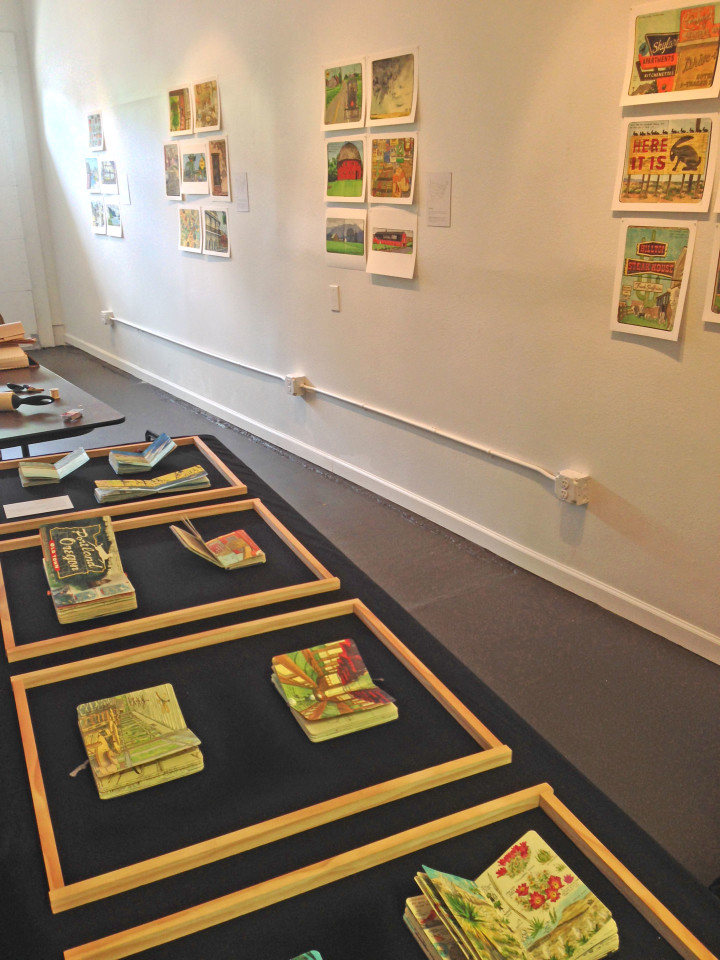
The show consists of ten original sketchbooks, paired with reproduction prints hung on the walls of the gallery. Displaying original sketchbooks is always another challenge, since it’s only possible to show one page at a time, and the books are delicate enough that they can’t stand up to constant handling during the show. But the folks who run Feast, Todd Jannausch and Chandler Woodfin (yes, there are two Chandlers involved here!), had the great idea of displaying the books in unobtrusive, handmade glass tabletop cases.
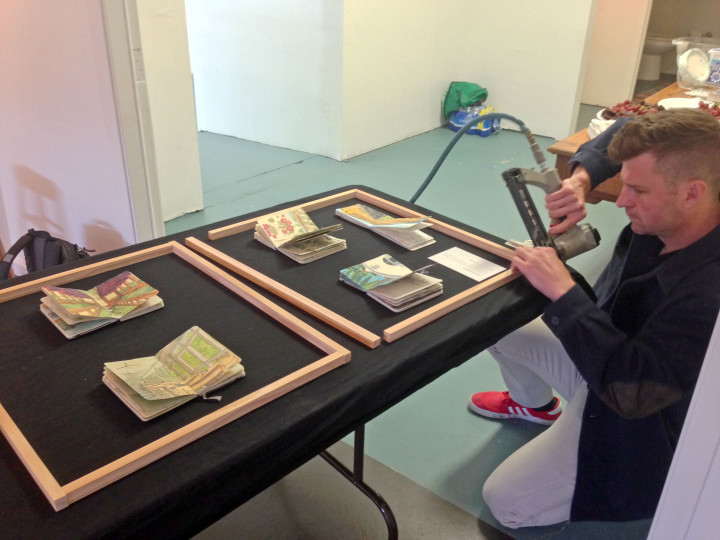
Here’s Todd putting one of them together—
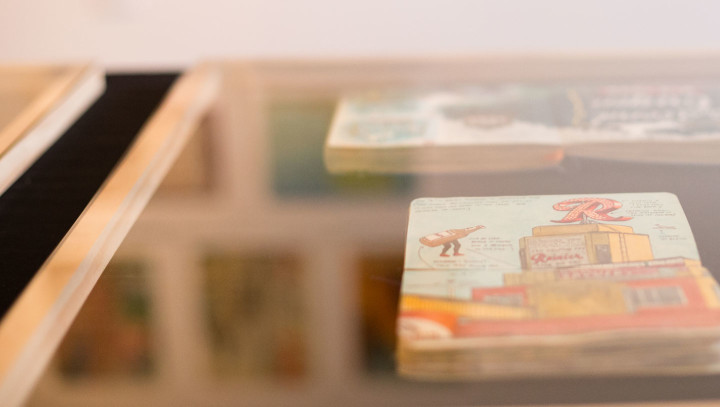
the end result is sleek and professional, and it made it easy for me to come in and turn the pages of each sketchbook once a week or so, to change things up during the show’s run and give folks the chance to see multiple pages over time.

These little map cards tie everything together, providing a little context behind the drawings and explaining my rationale for the themes I chose for the prints.
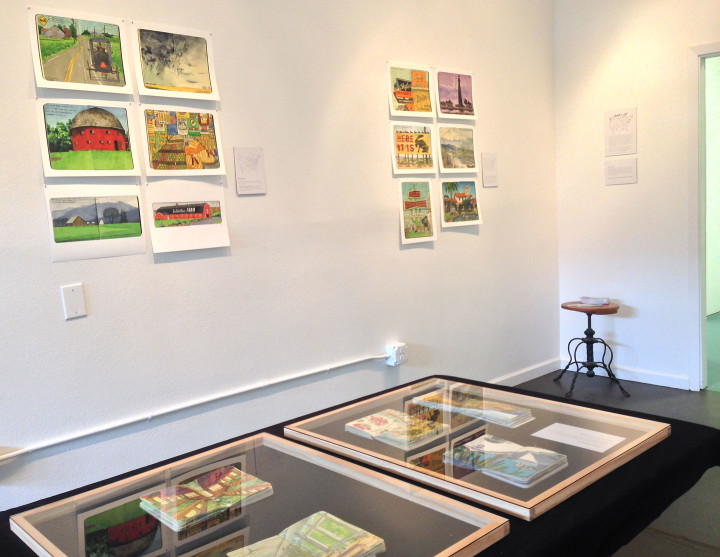
I’m so pleased with how the show came together—this has quickly become my very favorite solo show. So major thanks to Todd and Chandler for making it happen and handling the logistics!
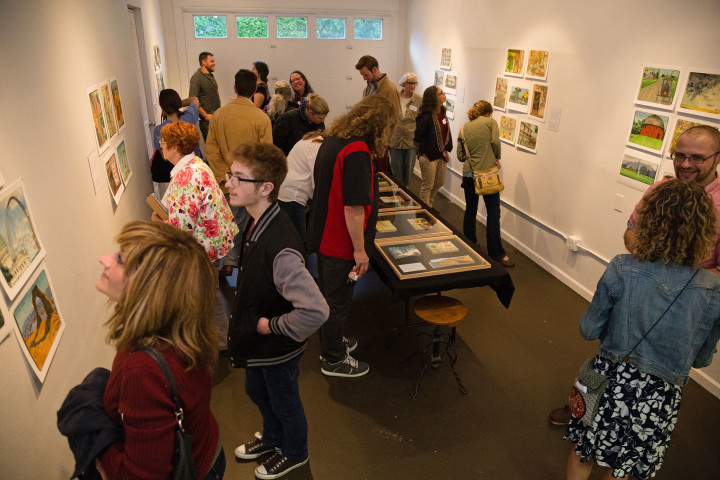
Photo by Shawn H. Nichols, taken at Artist Trust on Tour: Tacoma
As an added bonus, the folks at Artist Trust, a statewide arts organization, hosted an event to tie in with my exhibit opening. Since Artist Trust recently funded me with an artist grant to continue my sketchbook work, they asked me to speak about my process at the opening. I brought my very first travel sketchbook with me, and it was great to talk shop with the crowd that showed up that night!
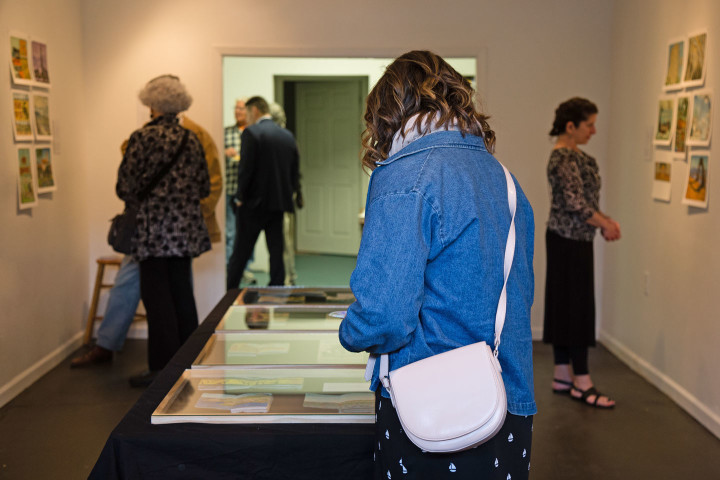
Photo by Shawn H. Nichols, taken at Artist Trust on Tour: Tacoma
The show closes on Sunday, June 12—here are all the details, if you’re looking to visit:
Jaunt + Jot: a solo sketchbook exhibition by Chandler O’Leary
May 19 through June 12, 2016
Feast Arts Center, 1402 S. 11th St., Tacoma, WA
Open Saturdays 12 to 4, Sundays 9 to 1, or by appointment

Photo by Shawn H. Nichols, taken at Artist Trust on Tour: Tacoma
Or if you’d like to try your hand sketching yourself, Feast, Urban Sketchers-Tacoma and I are hosting a special ad-hoc sketch outing this Sunday, June 5, as part of Feast’s Sunday Coffee series! The event is free and open to anyone who would like to try their hand at urban sketching—no prior experience is necessary, and all you need to bring are your own sketch materials (paper or sketchbook, pen or pencil, watercolors, or whatever you like to use).
Here’s how it works: Feast Arts Center will open at 9 am on Sunday, so visitors can see the exhibit. Anyone interested in sketching will gather at 10 am at Feast for a quick meet-and-greet. We will then split up and sketch around the Hilltop neighborhood; you can choose to stick around Feast, or wander farther afield and sketch whatever strikes your fancy. Some people sketch in groups, others go off by themselves. Then we’ll all meet back at Feast at 12:30 for an informal show-and-tell of our sketches. This part is completely optional (so if you’re nervous about showing your drawings, you don’t have to!), but it’s always fun to see everybody’s different styles, materials and points of view. Feast will remain open until 1 pm. Here are those details again, in digest version:
Ad-hoc Sketch Outing, sponsored by Urban Sketchers-Tacoma
Sunday, June 5, 2016
Feast Arts Center (open 9 to 1)
1402 S. 11th St. Tacoma, WA
1. Meet at Feast by 10 am
2. Sketch in and around Hilltop
3. Show & tell at Feast at 12:30
Please note that this is not a class or workshop, so neither I nor any Urban Sketchers members will be offering instruction. But this is a great opportunity to meet other sketch artists and find inspiration. People tell me all the time that they’d love to try sketching, but aren’t sure where to start. This is a great way to get your feet wet amongst friends—so don’t be shy! Grab your pencils, and we’ll see you this Sunday!
Creation of this work was made possible in part by Artist Trust Grants for Artist Projects. Special thanks to Artist Trust, Feast Arts Center, School of Visual Concepts, and Urban Sketchers-Tacoma.
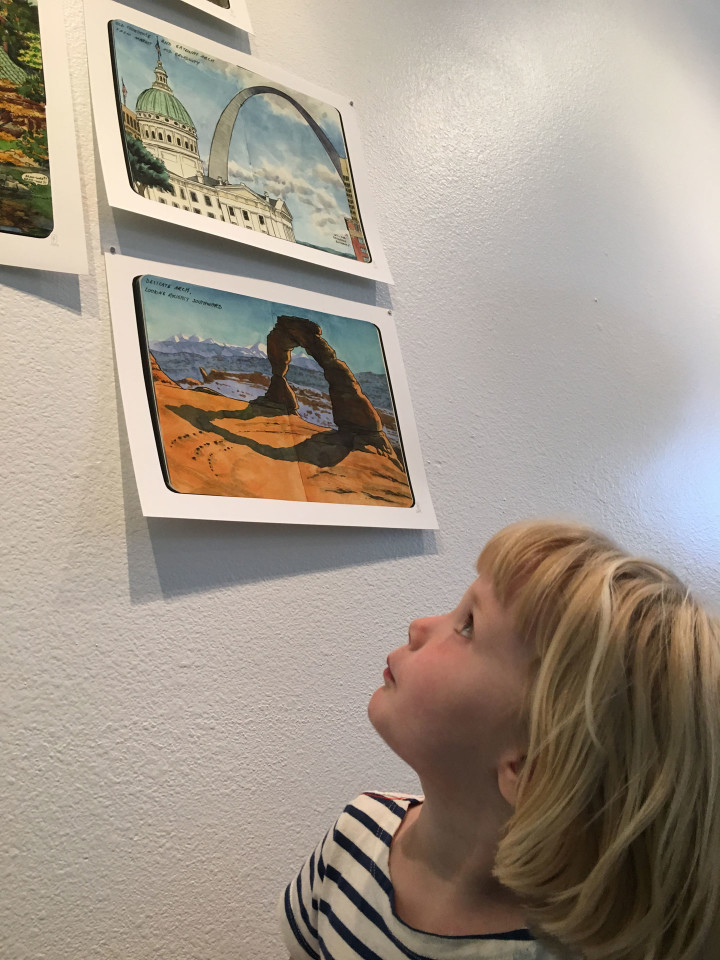
Photo by Mary Holste.
February 22nd, 2016

When it came time for us to find our next Dead Feminist, our thoughts turned to our own mirrors. Like every woman in our pop-culture-driven world, Jessica and I are bombarded with imagery and messages that urge us to scrutinize and criticize our own appearance. Unsurprisingly, we are taught to find ourselves lacking in one way or many, and to compare ourselves with an impossible ideal.
We were a little surprised to find courage and consolation in Ancient Greece, where they were all about the impossible ideal. Yet if you sift through the lofty architectural theory, stylized scenes and tales of the immortals, you’ll find a honey-tongued poet who speaks the plain truth: Sappho.
To be human is to grow old.

Our 23rd broadside, Age Before Beauty, reaches further back in time than we ever have before—to the 6th century BCE. As you can clearly see, the illustration is styled after the designs and motifs of ancient Greek pottery, right down to the amphora handles.
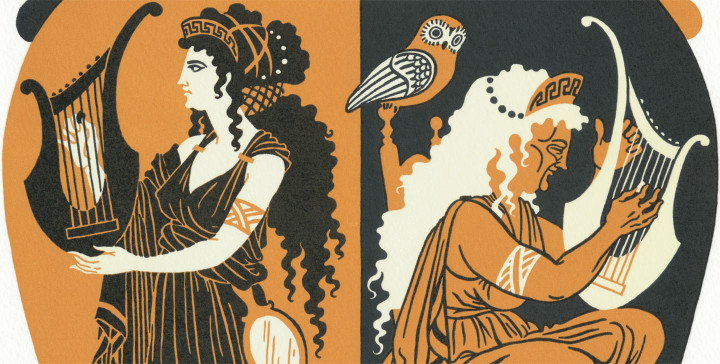
Yet even though she lived and worked thousands of years ago, Sappho’s words ring true as if they were written yesterday. We especially loved her self-reflection in the poem we chose, and the way she managed to view her aging body with kindness. It brought to mind, for me, an image of dual goddesses who are really two faces of the same woman—like the Maiden and Crone archetypes so common in other pre-Christian cultures.
Like the art of ancient Greece, the illustration is chock full of allegorical imagery. For instance, young Sappho carries Aphrodite’s mirror, while Athena’s wise owl looks over her aged self. Both figures play a seven-stringed lyre: Sappho was a lyrical poet, which means her poetry was designed to be performed to music. (Incidentally, some scholars also credit Sappho with the invention of the plectrum, a tool similar to a guitar pick that was used to pluck the lyre’s strings.) Finally, the band of dancing deer at the base references Josephine Balmer’s recent translation of Sappho’s Old Age Poem.

Compared to our previous broadsides, the composition and color scheme of this piece are fairly simple. The printing, on the other hand, was not. All those curves made it hard to line up the plates, and we had huge floods of color paired with delicate lines and text. To help her with the ink coverage and add just a tiny bit more pop to the color, Jessica ran the vase shape in a run of subtle cream first.
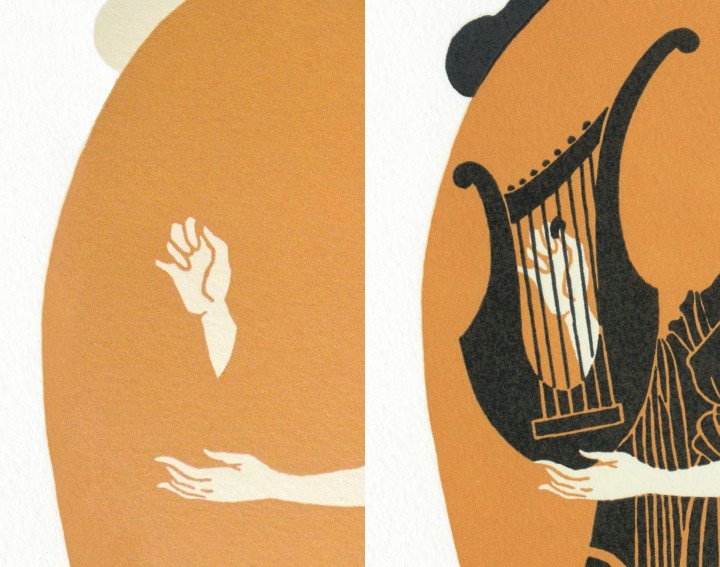
The cream pass helped with the super-tricky registration of the black and terracotta, as well.
All that fiddly and difficult technical stuff made the finished product that much sweeter. We’re pleased as punch about the results—we hope you will be, too.
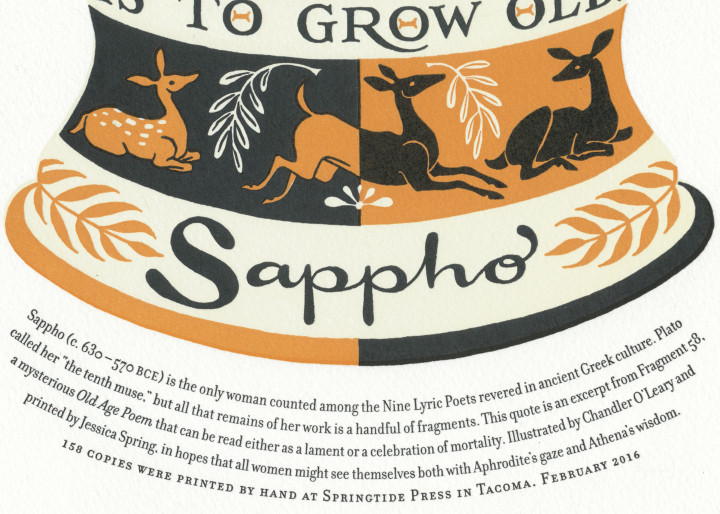
To help all women and girls see themselves in a more positive light, we are donating a portion of our proceeds to About Face. Founded in 1995, About Face works to improve girls’ and women’s self-esteem and body image by helping them understand and resist harmful media messages.
• • • • • • • • • • • • • • • • • • • • • • • • • • • • • • • • • • • • • • • • • • • • • • • • • • • • • • • • • • • •
Age Before Beauty: No. 23 in the Dead Feminists series
Edition size: 158 prints
Poster size: 10 x 18 inches
Printed on an antique Vandercook Universal One press, on archival, 100% rag (cotton) paper. Each piece is numbered and signed by both artists.
Colophon reads:
Sappho (c. 630 – 570 BCE) is the only woman counted among the Nine Lyric Poets revered in ancient Greek culture. Plato called her “the tenth muse,” but all that remains of her work is a handful of fragments. This quote is an excerpt from Fragment 58, a mysterious Old Age Poem that can be read either as a lament or a celebration of mortality. Illustrated by Chandler O’Leary and printed by Jessica Spring, in hopes that all women might see themselves both with Aphrodite’s gaze and Athena’s wisdom.
Now available in our Dead Feminists web shop!
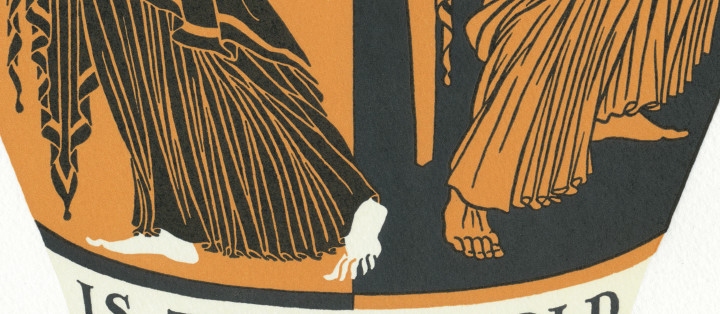
February 16th, 2016
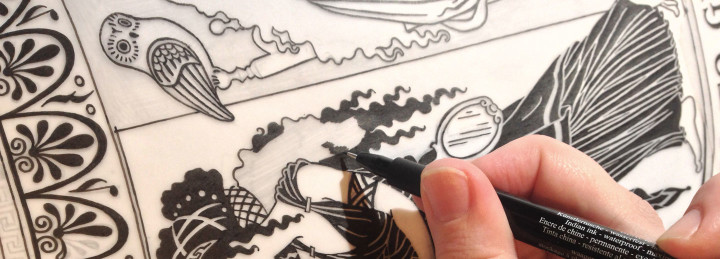
It’s that time again—we’re inking and printing up a storm right now, because we’re just about ready to introduce you to our newest Dead Feminist!
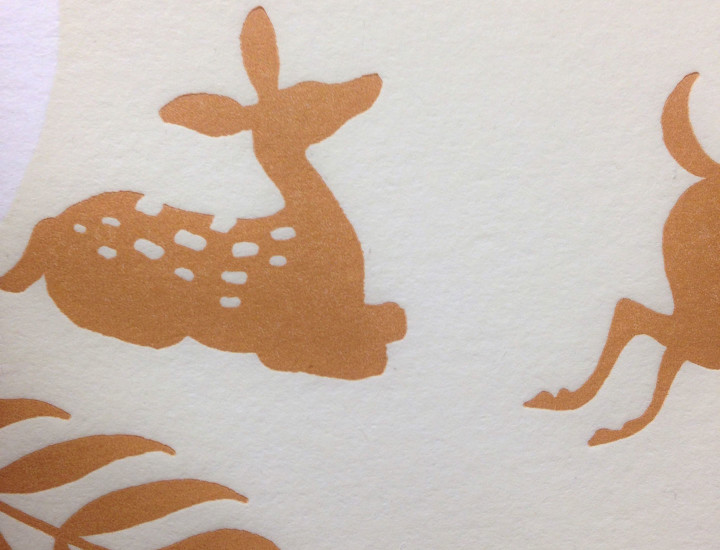
We hope you’ll like her as much as we do—after getting to know her history, we feel like she’s become something of a deer friend.
(Sorry, I can never resist a terrible pun.)
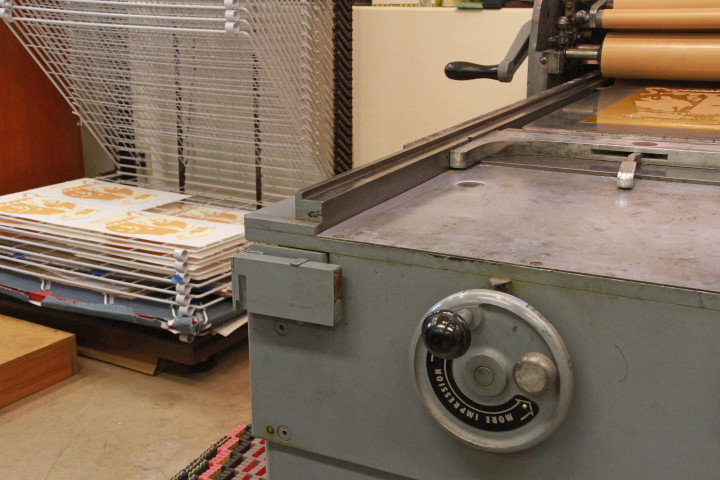
She’s already made her first (and second, and third) impression with us, and oh so soon she’ll do the same for you. Stay tuned!
February 8th, 2016
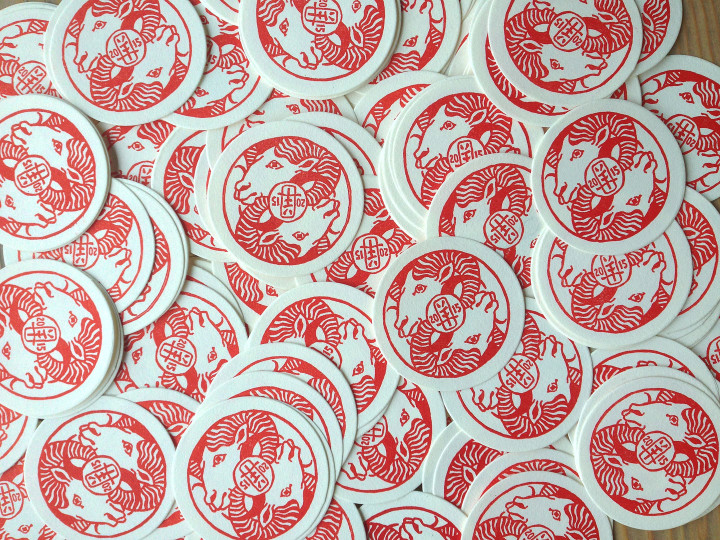
Well, now that it’s been a whole year since I first showed you these, and the secret no longer needs keeping, I can tell you about what I did today. Today is the start of the lunar new year, and here in Tacoma we have a tradition that proves how wonderful this town is, year after year. The tradition is called “Monkeyshines,” a public treasure hunt through the city that falls on (or around) the first day of Chinese new year each year. The name comes from the Year of the Monkey on the Chinese zodiac cycle, exactly twelve years ago, when an anonymous artist going by the name “Ms. Monkey” created a few hundred colorful hand-blown glass floats, each one stamped with a monkey design, and hid them all over the city. Anyone who found one could take it home with them, and since only Ms. Monkey’s inner circle knew about it, it came as a complete surprise to those lucky few who found treasure that year. Over the years the tradition has grown and the secret has spread like wildfire, with more and more beautiful pieces of glass art being hidden around Tacoma with each cycle of the zodiac. Since the only rule is “take only one,” many people have taken to rehiding the ones they find, or contributing their own handmade treasures to the hunt. Not that it’s easy to find multiple Monkeyshines—or even one! Even now that there are thousands of treasures hidden each year, it’s still like finding the proverbial needle in the haystack. I’d never been lucky myself, coming up empty-handed year after year.
2015, the Year of the Ram, completed the 12-year zodiac cycle that started with that first treasure hunt. Ms. Monkey approached me (no, I won’t tell you who she is!) and asked if I would contribute some “Monkeyshines” of my own to the cause. I jumped at the chance: even though I’d never found a glass float myself, I loved the hunt, and by then I’d amassed a mental database of potential hidey-holes. By then I was more excited about the prospect of hiding treasure than of finding it. Besides, even though my work has been moving away from letterpress printing in recent years, it was fun to do a printing project again.
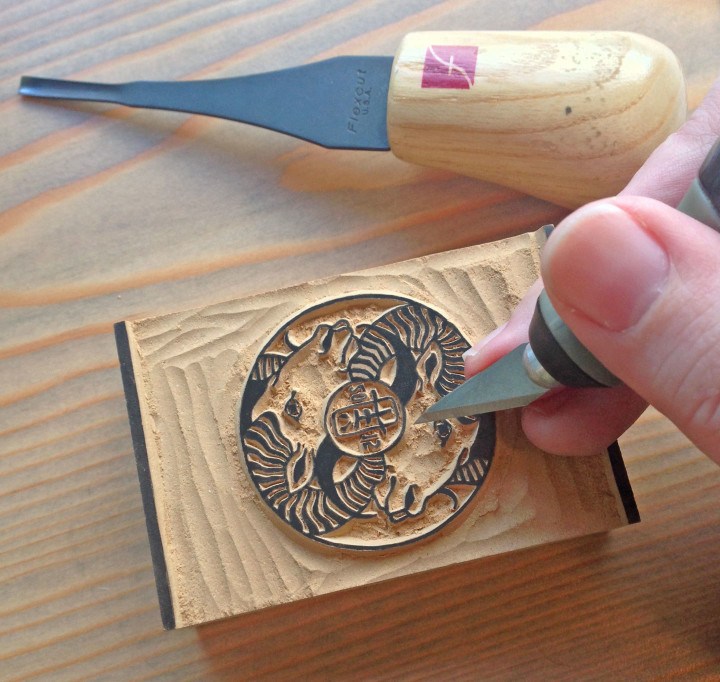
So I whipped up a little medallion design, and hand-carved it in linoleum.
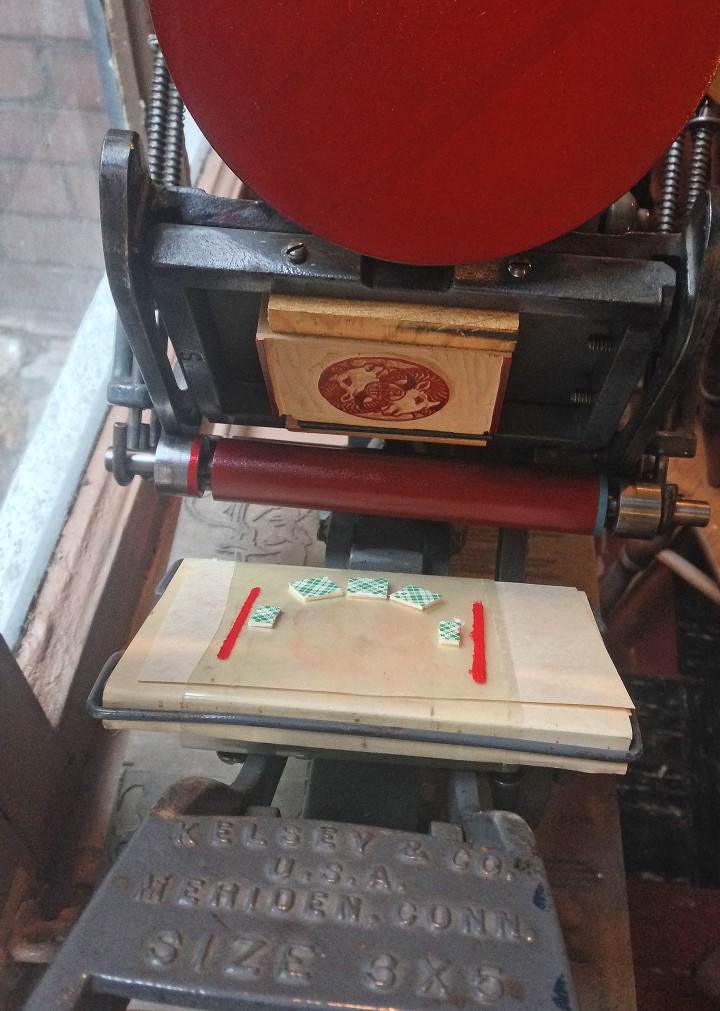
Then I threw it onto my tiny tabletop press, and set to work.
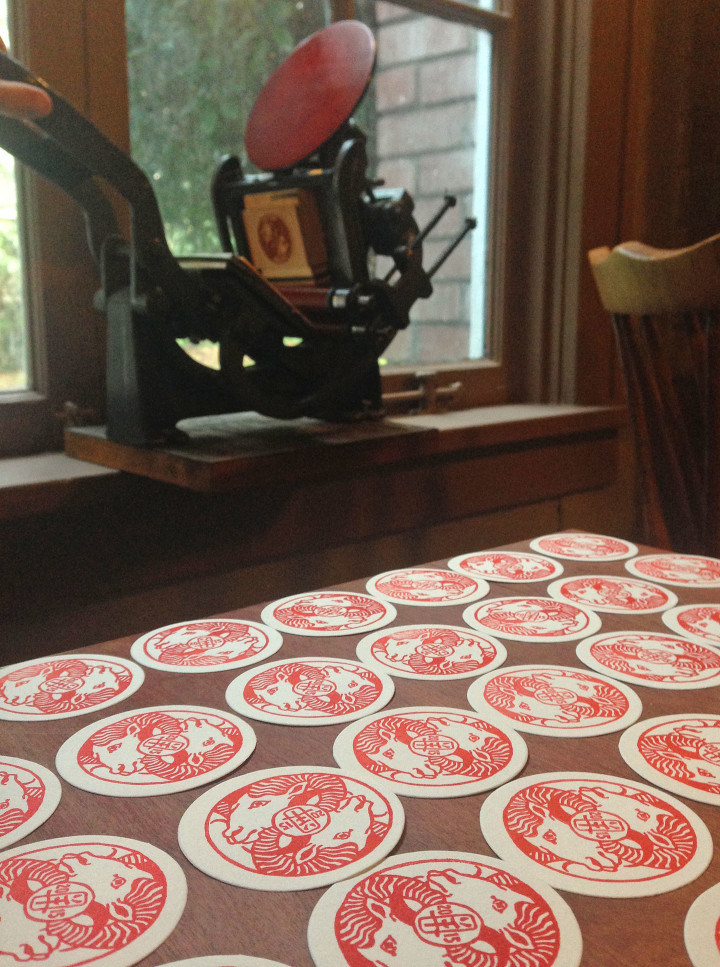
I printed close to 500 medallions (until I ran out of paper and the block started to break down!), and then hand-assembled them in the style of my other letterpress ornaments.
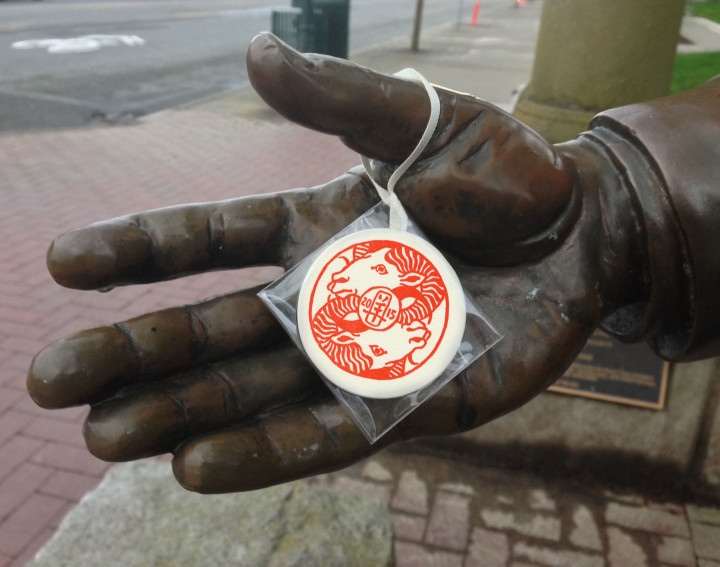
And then came the fun part: hiding them all over Tacoma.
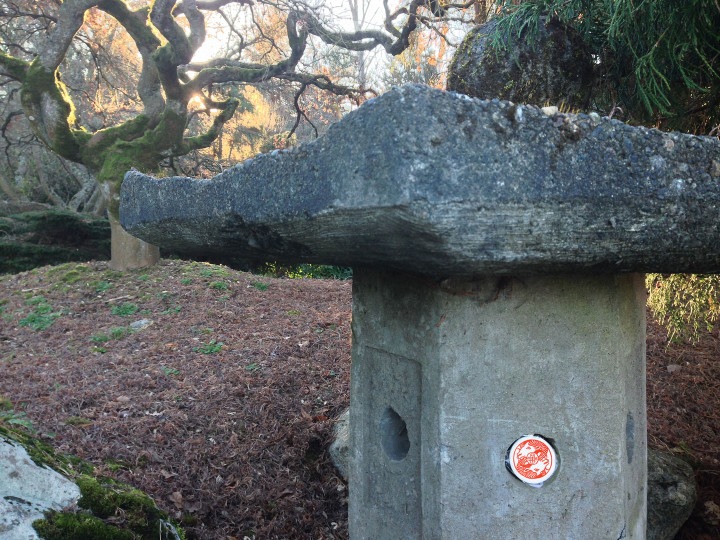
Since there were so many medallions, and I had to go out of town over Chinese new year, I enlisted friends to help, and staggered my own distribution over several weeks. Together we managed to canvass almost the entire city map, hitting both well-traveled areas and less-visited neighborhoods.
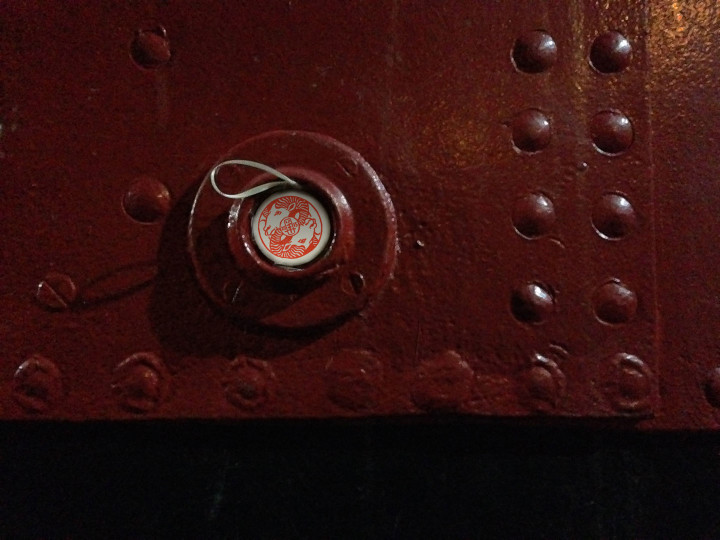
The hiding was, indeed, the best part. I loved walking inconspicuously at weird hours, my hands stuffed in my pockets and posing as a searcher, waiting until the coast was clear to pop another medallion into one of Tacoma’s nooks and crannies. Sometimes I’d hang around and wait nearby until someone came by and discovered what I’d left behind. It was a thrill every time.

I saved this pictured for last because it echoes this year’s odyssey, when my chance finally came. Fast forward to this morning, and it’s the Year of the Monkey all over again. Since it’s now become a tradition as ingrained as Christmas, there was no question that I’d resume the hunt. A friend came to pick me up at 4:30 am, and after a quick swig of coffee, we set out.
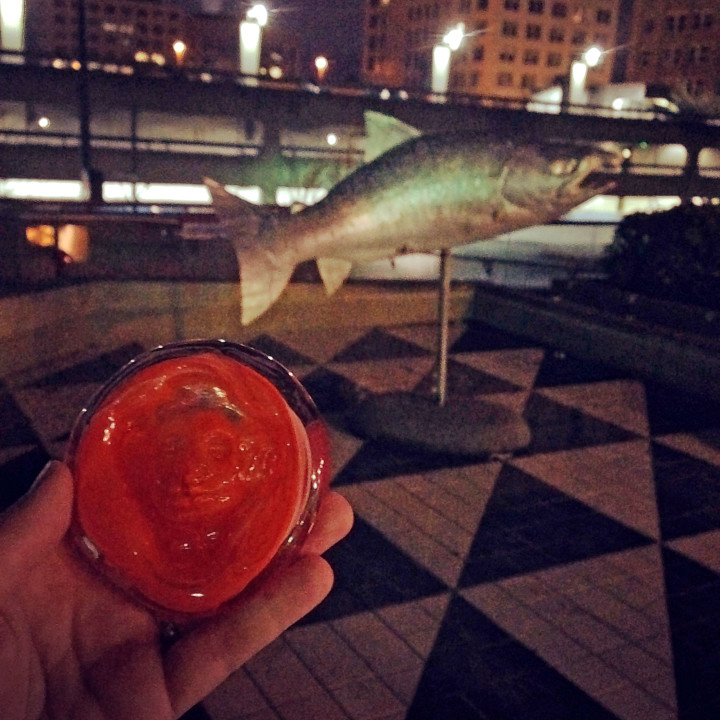
And in less than an hour, in my eighth year of searching, I finally found my first glass Monkeyshine! Just like the previous picture, it was in the mouth of a fish sculpture—this one in the middle of a fountain downtown. Luckily for me, there was only about an inch of water in the fountain, so all I had to do was climb in and step right up. And yes, if the fountain had been full of water, I would have gone in anyway, 35-degree weather be darned. I wouldn’t have been the only one—tales of people braving murky koi ponds and polar-plunging into the Bay have become the stuff of legend around here. For some things it’s worth getting soaked and dirty!
My friend is still searching for his Monkeyshine—we spent the rest of the morning hunting on his behalf, but even if he doesn’t find one this year, we made sure to pay it forward by hiding a few small monkey-themed treasures ourselves.
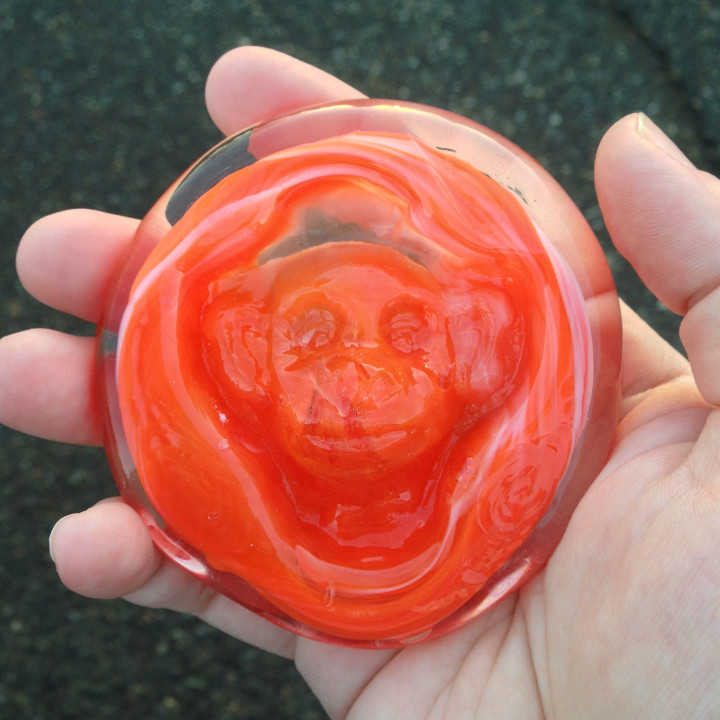
So now I’m back home, refreshed after a nap and a hot cuppa tea, admiring the Monkeyshine that’s serendipitously in my favorite color. SO many thanks to Ms. Monkey, all her fellow ‘Shiners, all the friends and friendly strangers I hunted with this morning, and my art-loving city. Thank you for making this happen year after year, for making my year so far, and for bringing us all together for a chance to play explorer in our own hometown. Gung hay fat choy!
August 6th, 2015
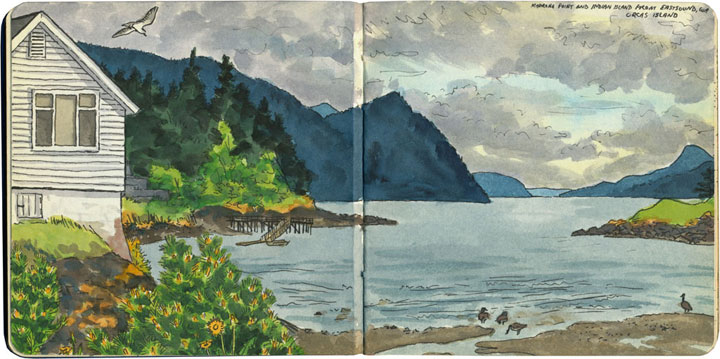
I can hardly believe it, but I’ve now lived in the Pacific Northwest for seven years.
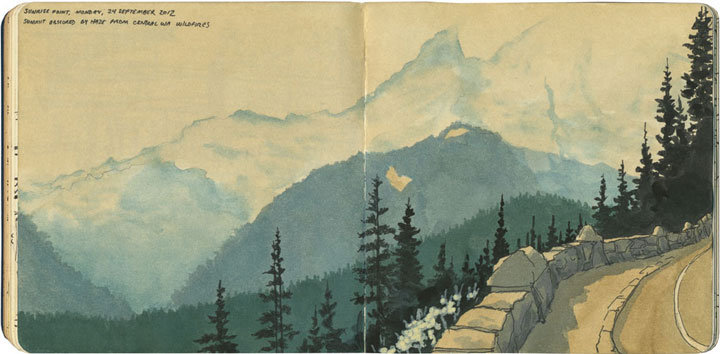
In that time I’ve done my very best to see as much of the region as possible, and document it all in my sketchbook.
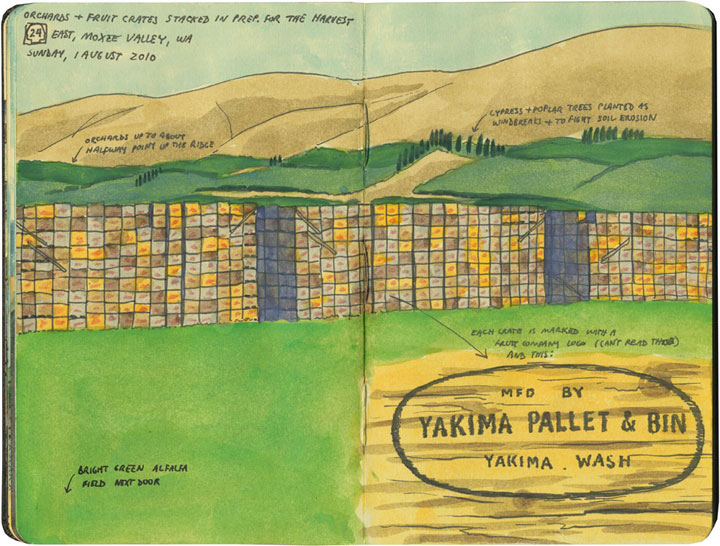
So in honor of seven years, here are seven sketchbook drawings—

—presented in no particular order—

—of some of my very favorte places

and moments
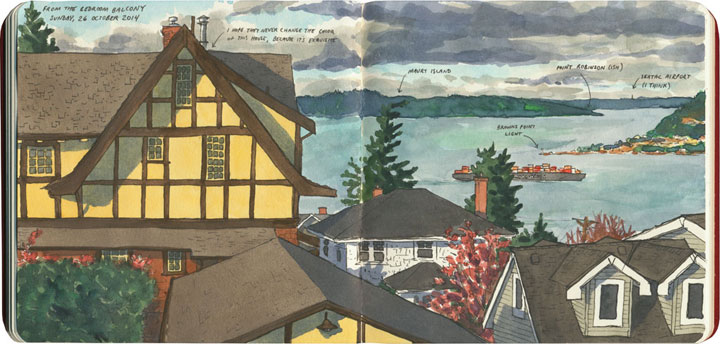
in the place I now call home.
April 27th, 2015
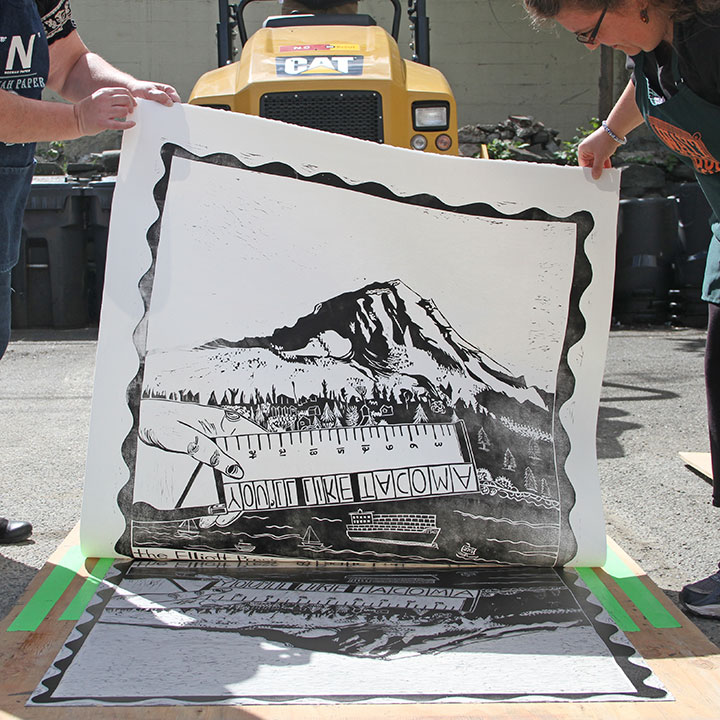
I only have a few photos of Wayzgoose to show you this year, because just manning my table had me so busy that I barely made it outside all weekend. I think making it a two-day event gave us a record-breaking attendance, and the weather came through to allow the steamroller artists to shine.
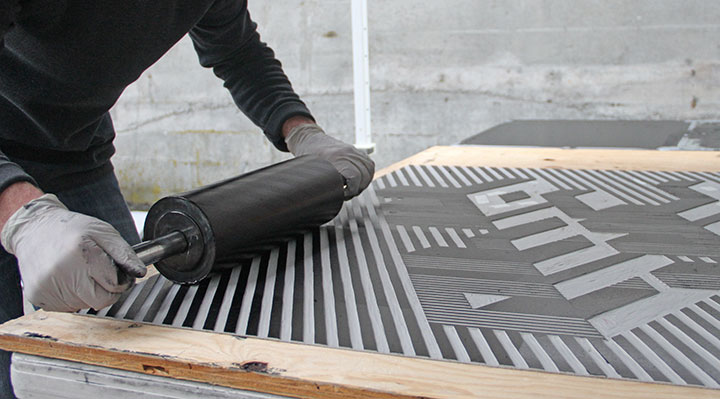
So I’ll just leave you with a few snippets of the weekend’s highlights,
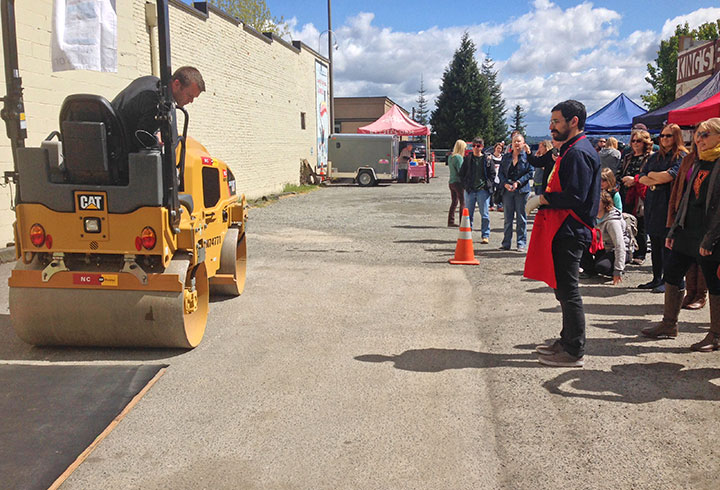
and hopefully tempt you to come and see us next year!
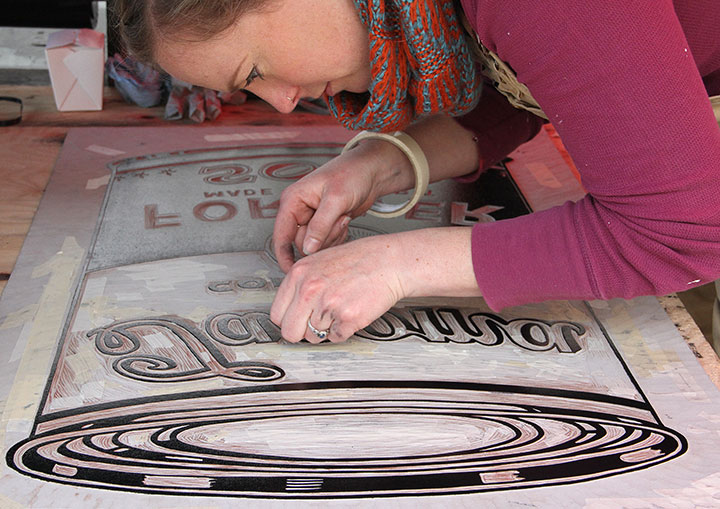
Many thanks to the fabulous artists and printers who make Wayzgoose the best arts event in Tacoma (not that I’m biased or anything…); to King’s Books and the Tacoma Arts Commission for making it possible; and to our founder Jessica Spring and her crew of volunteers for running a tight ship.
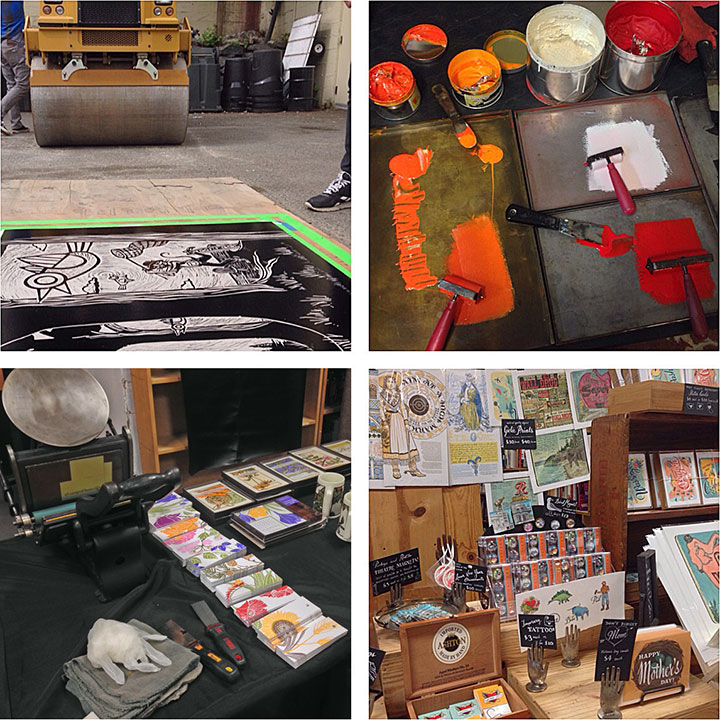
Most of all, thank you to the many hundreds of lovely Tacomans (and Seattleites! And Portlanders, too!) who come to show their support for what we do. My favorite part of Wayzgoose is how every year it reminds me just how much I love my city, and the people in it.
See you next year!
April 24th, 2015

We’re ready for the Wayzgoose tomorrow—are you?

I’ve got a whole host of new paper goods ready to show you (look for some of them online next week), and you’ll find them at my Wayzgoose table this weekend. So if you’re local, strap on your printing apron and come on by for the biggest print event of the year.
See you there!
April 21st, 2015
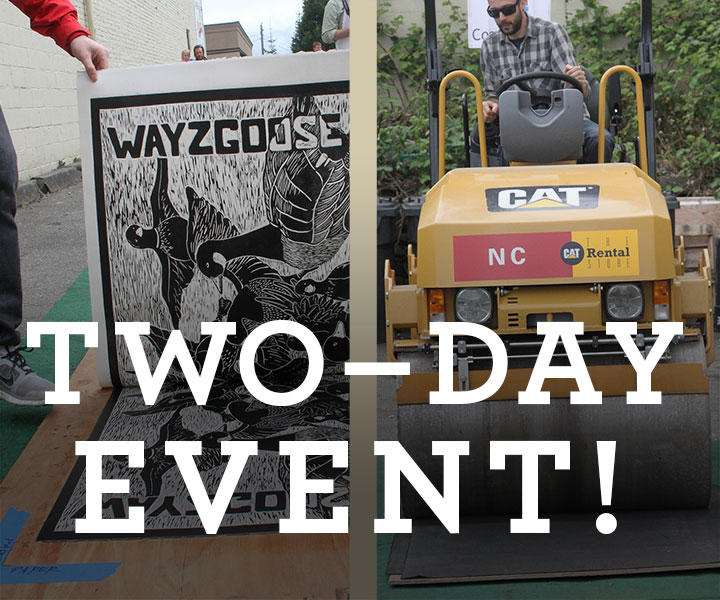
It’s that time of year again—the annual Tacoma Wayzgoose (our local letterpress and book arts extravaganza) is just around the corner! This will be the eleventh year of the event, and we’re expecting a record crowd. Because attendance has grown so much over the years, we’re expanding to meet the demand. For the first time ever, Wayzgoose will now be a two-day event, with artist vendors and steamroller printing on both days:
11th Annual Tacoma Wayzgoose
Saturday and Sunday, April 25-26, 2015
11 am to 4 pm, Free!
King’s Books
218 St. Helens Avenue, Tacoma, WA
Jessica and I are sitting out the steamroller printing this year, to give more newbies a chance to play, but we will both have tables inside. So make sure to stop by and say howdy, and see all the new goodies we’ll have there!
As always, I like to give a run-down Wayzgeese Past—and the list is getting mighty long! So if you’re new here and don’t know what a Wayzgoose is, or you just want to relive the glory days, here are my posts from previous years:
• 2009 (Tacoma)
• 2010 (Tacoma)
• 2011 (Tacoma)
• 2011 (San Francisco)
• 2012 (Tacoma)
• 2013 (Tacoma)
• 2014 (Tacoma)
All fired up? Good. See you this weekend!
The Tacoma Wayzgoose is a collaboration between King’s Books and Springtide Press with support from the Tacoma Arts Commission. Steamroller Printing is possible through a partnership with neighboring businesses Doyle’s Public House, the Harmon Tap Room, and The Hub. Many thanks to legions of volunteers who make this event possible, especially from our local institutions including Pacific Lutheran University, University of Puget Sound, Charles Wright Academy, Stadium High School and Tacoma Community College.
April 6th, 2015

I took a rare day off on Friday, to get out of the studio and gather some inspiration in the…um..field.
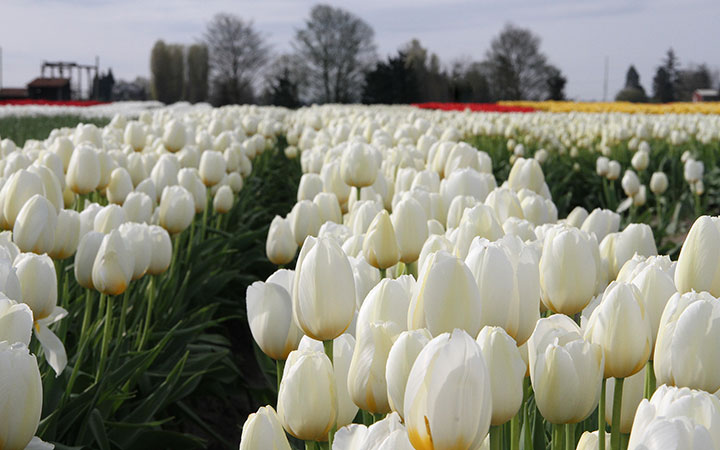

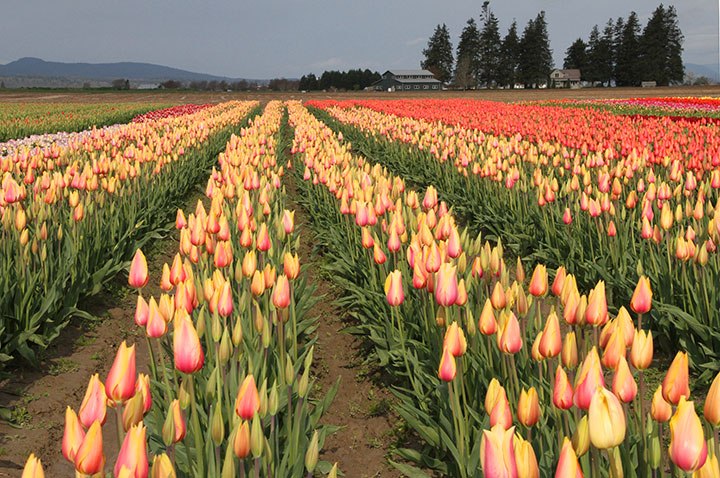
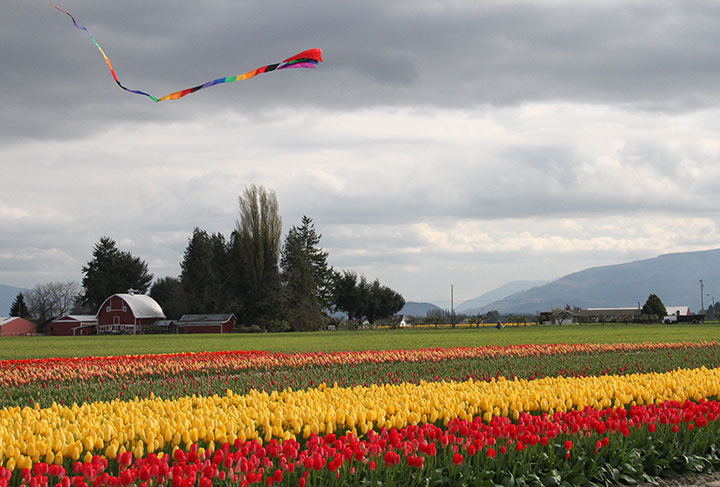

My trip turned into a mini-adventure,
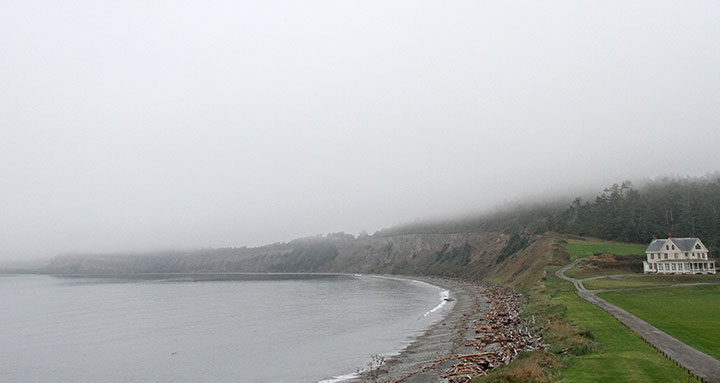
full of Washington wonders.
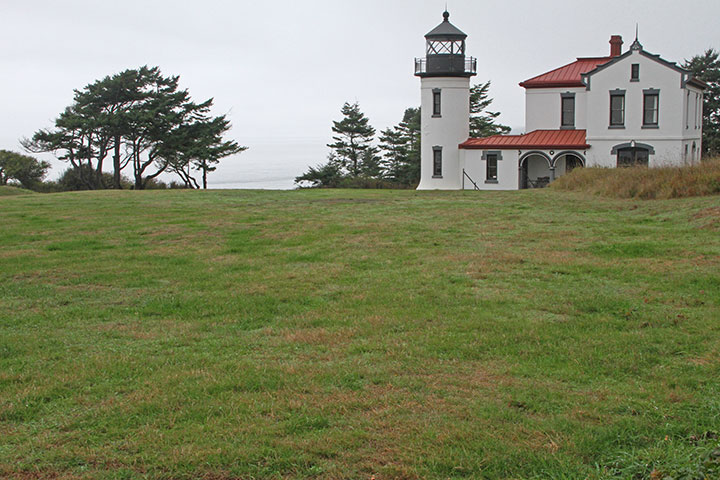

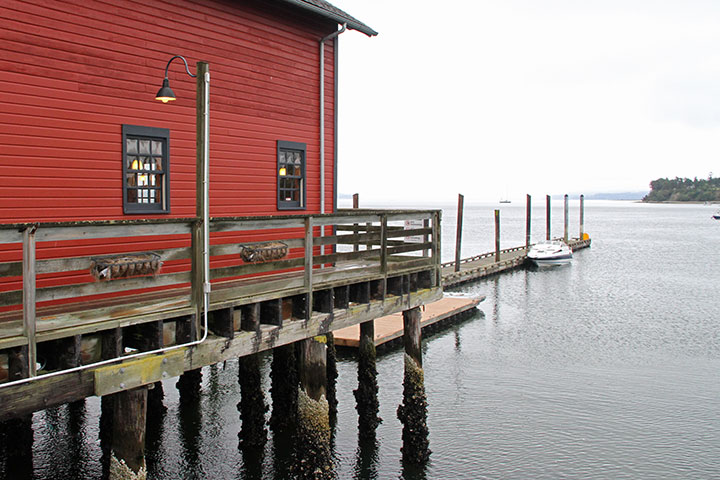
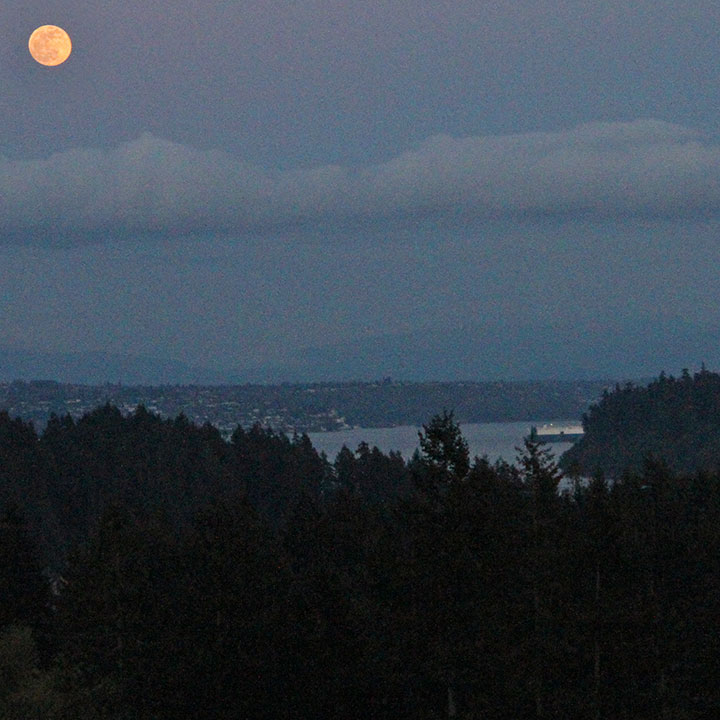
Catching the moonrise on my way home was an extra-special bonus, because it reminded me to set an alarm—

—so that I could catch a nice postscript to the day’s excitement.
March 16th, 2015
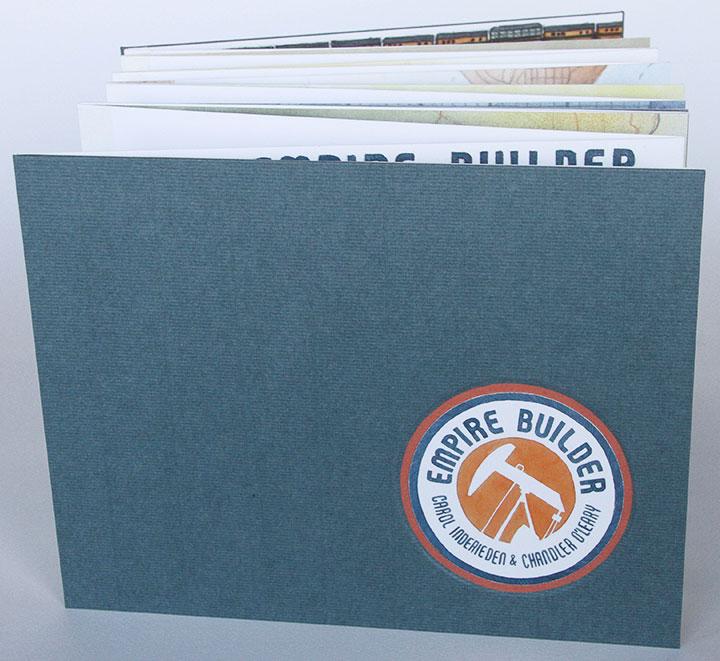
It’s been more than four years since my last artist book (which, incidentally, I’m still working on)—I guess it’s been that long since I had something to say that warranted a multi-page art format. I suppose when it rains, it pours, though—because with this new project, there’s so much to say that an artist book can’t quite contain it all. This project has got words and images spilling out of me every which way. So fair warning: this is going to be a long post. There’s a lot to show you, and a lot to explain; there’s really no way to tell you this story without telling you all of it.
Before I get too far into it, though, I’ll give you the short version. Pictured above is my new artist book, entitled Empire Builder. It’s a collaboration with my friend Carol Inderieden, who is also a writer and illustrator. The book is about oil—that controversial new hydraulic fracturing (“fracking”) process, to be precise.
(If you want to stop reading now, I’ll understand. But if you’re stouthearted enough for a lot of backstory, let’s dive in.)

For me, it all started with this sketch.
The Tailor and I were in the middle of a cross-country road trip in 2011. One of our planned stops was Theodore Roosevelt National Park in western North Dakota. That part of the state was an old haunt of mine (I lived in North Dakota for several years), and I was excited to show my spouse a place I knew so well—or at least, I once knew. When we got there, I was utterly unprepared for how quickly and drastically the place had changed. I knew the oil boom had begun there, but I had no idea I’d find the landscape almost unrecognizable.
The once desolate highway was nearly at a standstill with traffic. Every hillside was occupied with RV camps and oil platforms, all built around the process of extracting crude from the Bakken Shale below ground. It was the end of the work day, so there were people everywhere—and we felt conspicuous with our out-of-state plates and tree-hugger-model car. Needless to say, I didn’t feel comfortable taking photos with my giant (and not at all discreet) camera. So instead I pulled out my sketchbook and jotted down the scene, right there in the moving vehicle, while the Tailor drove. It’s the only image I captured of the oil fields, but I still look at this and remember every detail of that afternoon.
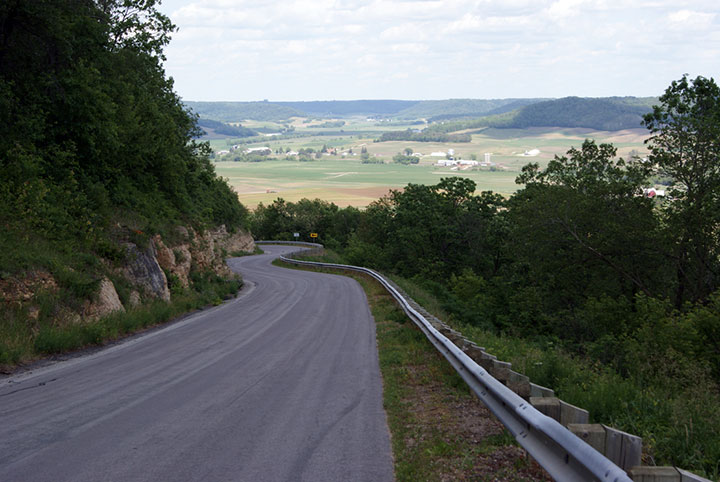
A little later I was relating the story to Carol, and she knew all too well what that day felt like for me. Carol lives in western Wisconsin, in an area called the Driftless Region—so named because unlike the lands surrounding it, the area was never glaciated during the last ice age. So Carol’s neck of the woods has a dramatic beauty to it, with deep valleys, swift rivers and sheer cliffs—a landscape very different from the rest of the state (this is her photo, by the way). The Driftless Region is also unique in that the bedrock there is rich in silica—something that has suddenly become extremely valuable to the new oil industry. Carol explained to me that in the past few years, oil companies have been buying up farmland in her area for strip mining, and excavating huge quantities of silica-rich sand for use in the frac drilling process in the Bakken oil fields. What I glimpsed in one afternoon in North Dakota, my friend has watched unfold on a daily basis, right in her back yard.
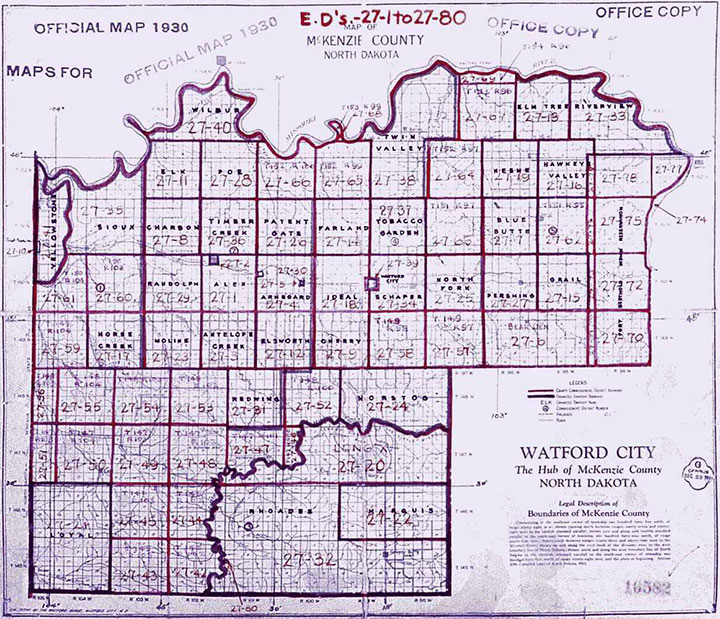
Her story, and what I saw in North Dakota, reminded me of what I’d read about the pioneer days—of dramatic land grabs, of politicians carving up maps of regions they’d never see in person, of arbitrary grids imposed on wild landscapes.
Anyway, fast forward a few months more, and I start seeing local newspaper stories about Bakken crude oil trains arriving in Seattle and Tacoma in huge numbers, and how devastating a derailment, spill or explosion here could be. All of a sudden, the fracking industry was in my back yard as well—not just some faraway place I happened to have personal memories about.
So I did what I always do: I started thinking about how I might turn my thoughts into an art piece. I called Carol and asked her if she might want to collaborate on a project about all of this. It wasn’t long before we decided on an artist book—which would end up taking us on a two-year odyssey before it was finished.
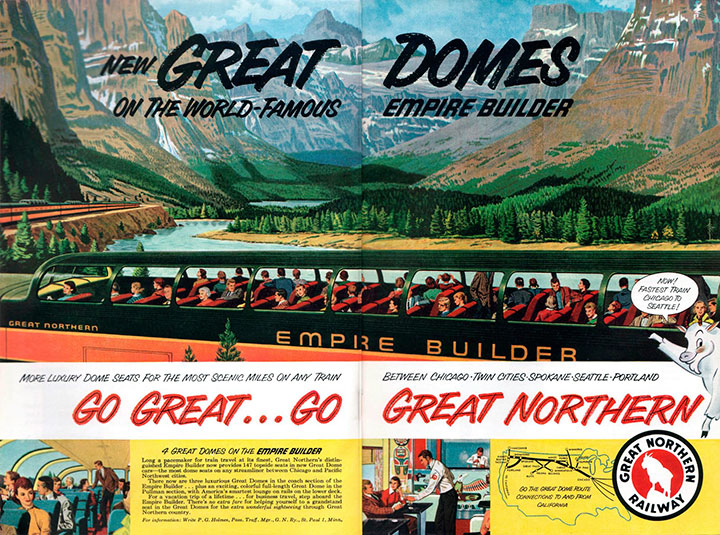
We wanted to link these three regions (the Driftless Area, the Bakken Shale, and the Pacific Northwest) together somehow for our book, and we had a perfect, ready-made means by which to do so: the railroad. Not only was there a train that stopped in all three places (and both Carol and I have traveled on that train), but we soon learned that the entire supply chain for the frac industry followed the path of the Empire Builder railroad line, from Chicago to Seattle. We couldn’t believe how perfect it was.
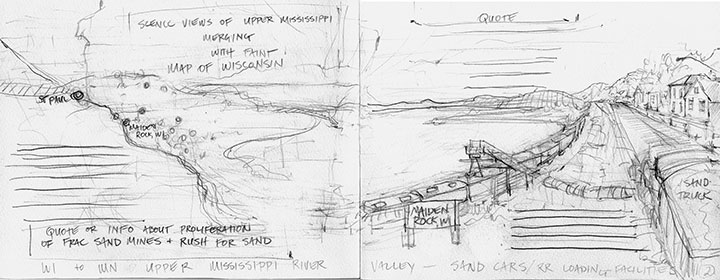
The railroad ended up becoming the backbone of every part of our book: concept, historical framework, even physical structure.

Whenever we weren’t sure what to do, the railroad brought us back to center, and kept our sequence in order.
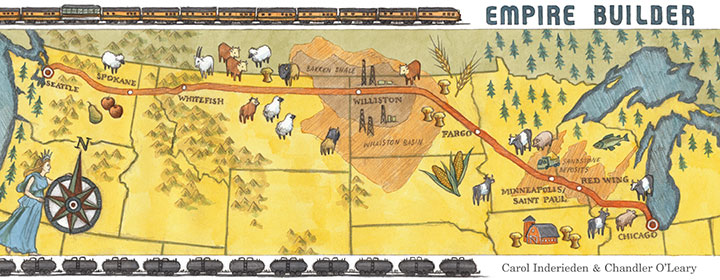
What proved to be more difficult was just which story to tell within the pages. As you can see by this already out-of-hand blog post, we had a lot to say, and we couldn’t possibly say everything. We didn’t just want the book to be a 20-page rant on our feelings about the environment, nor a didactic explanation of how the frac process works. We wanted to show, rather than tell. We wanted to make our readers fall in love with these landscapes as we have. We wanted to provide evidence of the consequences of the oil boom. And we wanted to create a tangible link to history, because all of this has happened before. But our text and images were coming up short; we needed something extra to tie everything together.
Carol came to the rescue, by finding a short quote that embodied the mood we wanted to get across. It added an air of foreboding to the piece, and it worked perfectly with all the allegorical images we were throwing around. And here’s the wacky thing: the quote is from the New York Times. In 1861. And it fits so well with what’s happening now that it easily could have been written yesterday. Here’s the quote:
We have all our little troubles in this life, and for those who are not too proud, to use a popular phrase, it may be added that we have all our elephants to see. It is narrated of a certain farmer that his life’s desire was to behold this largest of quadrupeds, until the yearning became well nigh a mania. He finally met one of the largest size traveling in the van of a menagerie. His horse was frightened, his wagon smashed, his eggs and poultry ruined. But he rose from the wreck radiant and in triumph. “A fig for the damage,” quoth he, “for I have seen the elephant!”
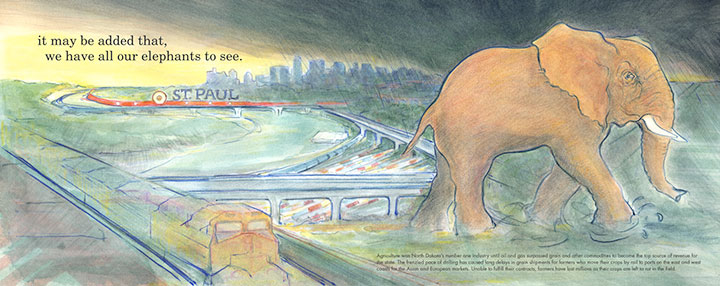
In the end, we ran the quote in pieces throughout the length of the book—and paired it with illustrations chock full of historical allegory (as well as allusions to old train advertisements, wartime propaganda, and current events). Explaining it all would make this even longer a post than the novel it already is, so I’ll just present our essay at the end of the book to give you the full context behind the quote.
• • • • • • • • • • • • • • • • • • • • • • • • • • • • • • • • • • • • • • • • • • • • • • • • • • • • • • • • • • • •
The preceding quote, from an 1861 New York Times editorial, highlights a phrase popular in America during the latter half of the nineteenth century. “Seeing the Elephant” was a figure of speech that came to embody the pioneer experience during the era of westward expansion. To see the elephant was to embark on a quest for riches and prosperity. It alluded to the danger and excitement associated with seeking one’s fortune in an unknown land. The elephant is an illusion, an impossible promise like a desert mirage that disappears as one moves closer. “Seeing the Elephant” later became synonymous with the bitterness and disappointment settlers experienced as they watched their dreams turn to ashes. During this time, the idea of Manifest Destiny — the 19th century notion that Americans possessed the divine right to claim all of North America, by virtue of their moral superiority — was also born and sometimes depicted as the mythical goddess Columbia, leading brave settlers westward.
“Seeing the Elephant” gradually fell out of the vernacular, yet the sentiment endured as the double-edged sword of the American Dream. Evidence of this can still be found in every corner of the West. Prairie homesteaders planted tree claims as a winning bet against Uncle Sam and lost. Tenement families in the East sold everything to migrate westward and buy into the myth of dry-land farming. Wildcat prospectors gambled their lives for oil, silver and gold. Families in the roaring twenties bought on credit, stacking the deck with status symbols before losing it all in the Great Depression. Suburban subdivisions, once symbols of postwar prosperity, have now become outposts of the working poor. The cycle of boom and bust has been resurrected so many times that the Elephant has grown in size from a distant vision to an omnipresent burden, stretching from sea to shining sea.
If the American map were the Elephant writ large, it is the railroad that breathes life into the creature. Throughout the last century of rail development, the anatomical structure of a complex organism has evolved. Today spurs and trunk lines follow a vascular system that carries a lifeblood of raw materials across the nation in a never-ending stream of freight. While the Elephant’s lungs fill with natural gas, its veins run gold with domestic oil and its heart beats ever faster in the Bakken Formation of western North Dakota.
Even in today’s age of dwindling resources and dire environmental warnings, Americans still see the land as a bottomless well to be tapped. In the Bakken, a new frontier has opened and is flooded once again with a new generation of fortune-seekers. “Man camps” dot once-empty hillsides and roughnecks push the region’s infrastructure to the breaking point. Remote rural highways and railroad lines are now choked with traffic. Flames from gas flares and oil slicks bathe the grassland in an eerie, unnatural glow. Yet while the land flows with modern milk and honey, only a few actually taste its richness. Companies grow fat while laborers vie for just a few drops. Communities swell to accommodate the boom, yet risk collapsing as soon as the inevitable bust occurs. All the while, the Elephant still waits beyond the next horizon and Columbia still beckons, just out of reach.
The backbone of the modern Elephant is the railroad line from Chicago to Seattle — incidentally, the same line that carries the Empire Builder passenger train. This train is aptly named for the exploits of James J. Hill, the railroad lumber baron who grew rich transporting timber and other raw materials from the Pacific Northwest to the cities and industries of the Midwest. Today one can ride the Empire Builder from one end of Hill’s domain to the other, and witness every element of the fracking process along the way. In the early 20th century, the Empire Builder encouraged travelers to “See America First” and marvel at the wonders of the natural world speeding past their windows. Today’s rail passengers watch the new Industrial Revolution rolling by.
This book is an attempt to articulate our dismay at the rapid transformation of a West we know and remember. We live and work at opposite ends of the Empire Builder railroad line: Carol in the Driftless Region of Wisconsin, where the bluffs and hillsides are being strip mined for frac sand; and Chandler in the Puget Sound area of western Washington, where Bakken oil is refined and shipped to other ports by tanker vessel. We both have personal ties to the northern Plains, though recent events render the region unrecognizable when compared to our memories. Still, the railroad connects us to each other and the landscapes we love. For the pioneers of the new era, the rhythm of the railroad is the marching song of progress — but for us, it is a lament.
• • • • • • • • • • • • • • • • • • • • • • • • • • • • • • • • • • • • • • • • • • • • • • • • • • • • • • • • • • • •
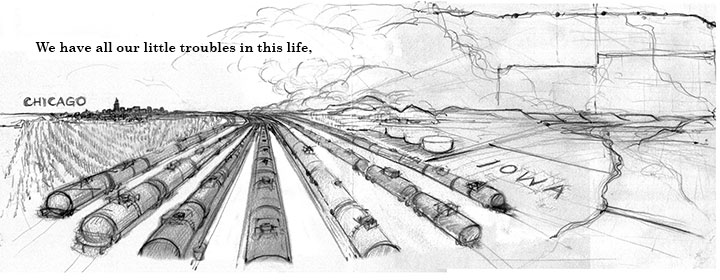
One of the best things about working with Carol on this project is that we both draw—and our aesthetics are not dissimilar. So we could match each other’s style to keep the book consistent throughout—without it being obvious who did which illustration. But that wasn’t the problem.
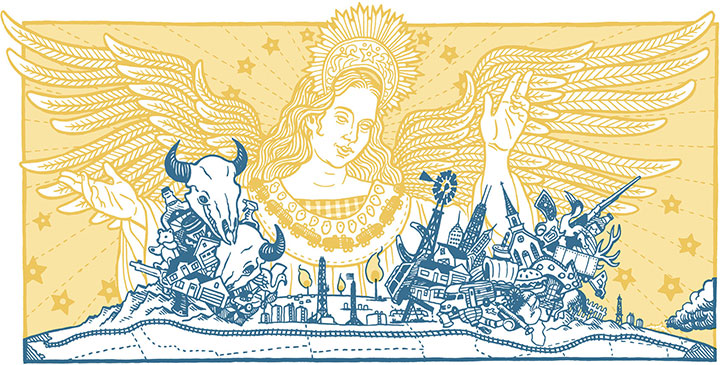
The problem was that we were originally thinking this book would be letterpress-printed. That would have meant our final illustrations would have to be extremely flat and graphic in style, to accommodate the limitations of hand-printing. This is a mockup I did at an early stage of our “Manifest Destiny” image. I hated it, and I didn’t know why at first. But then Carol and I figured out that what we really responded to was the loose, quick style of the sketch I did in North Dakota four years ago—which mirrored all our process pencil sketches for the book. The letterpress mockup I did above felt too slick, too…”set in stone.” It felt like the wrong medium to convey a phenomenon that is happening so rapidly that even the news media can’t keep up with it.
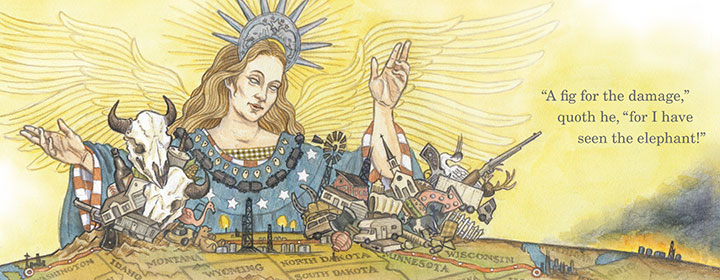
Sketching felt like the right medium—so we changed tack, and made our book a sort of Sketch Storybook instead. We let go of letterpress printing, and decided to digitally print the book—which freed us from all limitations when it came to the imagery.
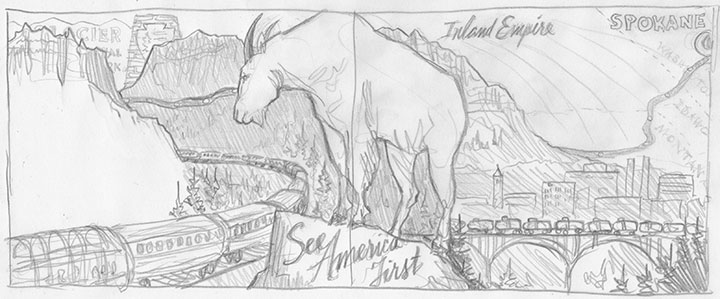
This way, we could preserve the immediacy of our sketch drawings—
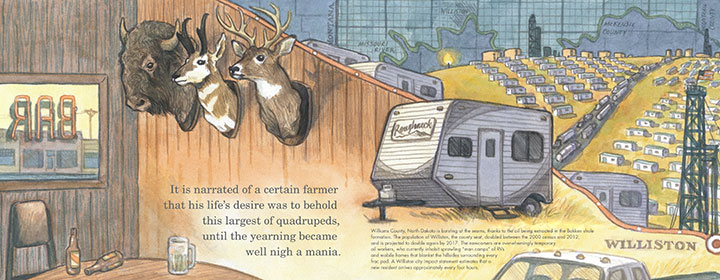
—and we could paint in watercolor right on top of our sketches, and reproduce each image in full color (another thing letterpress printing doesn’t allow).
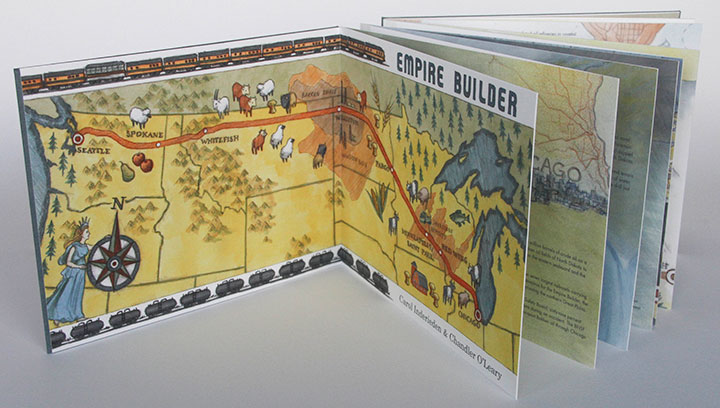
The finished product is an accordion-bound book that reads like a map—tracing both the route of the Empire Builder train and the path of industry and destruction, in one long, unbroken line. When fully open, the book is fifteen feet long.
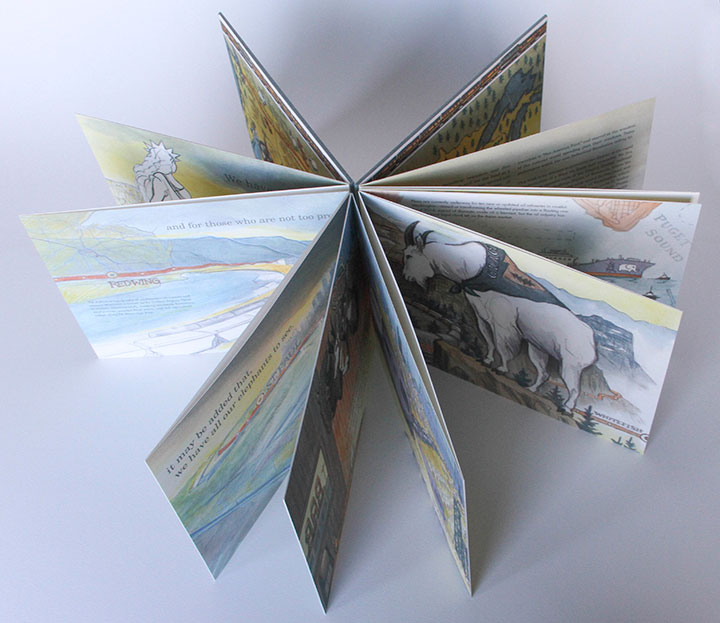
We printed a limited edition of just 50 books; each one is digitally printed on archival, 100% cotton paper, and hand-bound in hardcover with a paper slip case. Price is $600, plus shipping; we’re taking pre-orders on a first-come, first-served basis, and we’ll begin shipping finished books in April.
If you’d like to reserve a copy, drop me a line at chandler [at] anagram-press [dot] com .
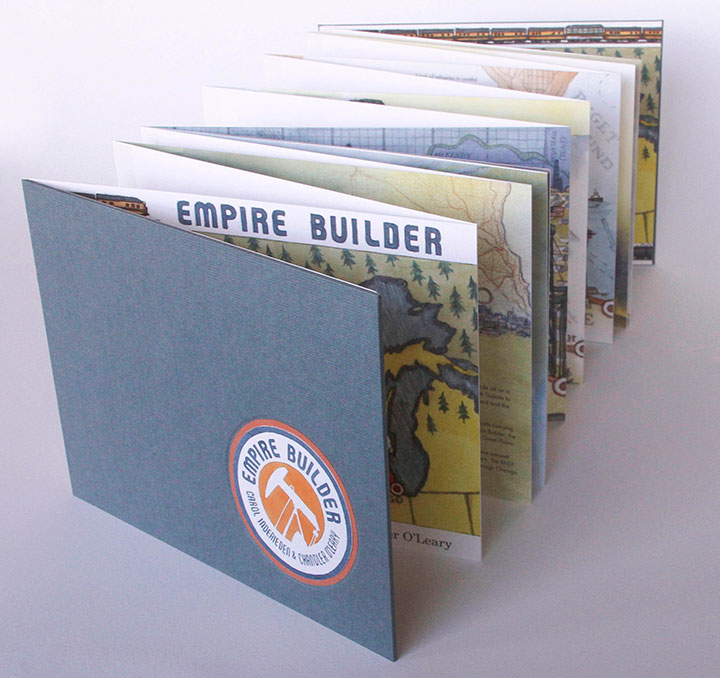
And if you’d like to see the book in person, it’s already making its way around the country to various shows, including a groundbreaking national exhibition on the Bakken oil boom at the Plains Art Museum in North Dakota. Here’s the scoop on where it’s been and where it’s going, so far:
Fifth CODEX International Bookfair
February 8-11, 2015
Craneway Pavilion, Richmond, CA
Bakken Boom: Artists Respond to the North Dakota Oil Rush
Group Exhibition
On display through August 15, 2015
Plains Art Museum, Fargo, ND
CODEX Finds
Group Exhibition
March 24 – April 25, 2015
23Sandy Gallery, Portland, OR
Carpe Librum
Group Exhibition
April 3-26, 2015
Bainbridge Arts & Crafts Gallery, Bainbridge Island, WA
2015 New York Antiquarian Book Fair
Empire Builder represented by the Kelmscott Bookshop
April 9-12, 2015
Park Avenue Armory, New York, NY
5th Annual Puget Sound Book Artists Member Exhibition
Group Exhibition
June 4 through July 31, 2015
Opening reception: Thursday, June 4, 2015, 5:30 to 7:30 pm
Collins Memorial Library, University of Puget Sound, Tacoma, WA
EDITED TO ADD: more shows featuring Empire Builder:
Beyond Brand
Group exhibition
July 30 through September 5, 2015
Opening reception: Saturday, August 1, 2015, 7 to 9 pm
Form + Content Gallery, Minneapolis, MN
The Art of the Book
Group exhibition
June 17 through July 27, 2016
Sebastopol Center for the Arts, Sebastopol, CA
Bridging the Waters
Group exhibition
July 1 through August 21, 2016
Center for Fine Print Research
University of West England, Bristol, United Kingdom
Heavy Metal
Group exhibition
August 31 through October 1, 2016
Berkeley Art Works
Martinsburg, WV
Local Heroes: Book Artists of Washington State
Group exhibition
October 15, 2016 through May 2, 2017
Bainbridge Island Museum of Art
Bainbridge Island, WA
The Illustrated Accordion
Group exhibition
May 5 – 26, 2017
Kalamazoo Book Arts Center Gallery
Kalamazoo, MI
Re-Sisters: Books & Broadsides by Chandler O’Leary & Jessica Spring
Two-person exhibition
February 6 through March 23, 2018
Bryan Oliver Gallery, Whitworth University
Spokane, WA
conTEXT: Broadsides & Artwork by Chandler O’Leary & Jessica Spring
Two-person exhibition
March 3 through April 29, 2018
Antenna Gallery
New Orleans, LA
Rising Together: Artists’ Books and Prints with a Social Conscience
Traveling group exhibition
On view from 2018 through 2021
Fall/Winter 2018: University of Utah Marriott Library, Salt Lake City, UT
Spring 2019: Center for Book Arts, New York, NY
Fall 2019: University of Iowa Center for the Book, Iowa City, IA
Spring 2020: Hoffmitz Milken Center for Typography, ArtCenter College of Design, Pasadena, CA
Fall 2020: University of Puget Sound Collins Library, Tacoma, WA (see above)
Spring 2021: San Francisco Center for the Book (in conjunction with Mills College), San Francisco, CA
Frozen Warnings
Group exhibition on the climate crisis
February 1 through May 3, 2020
Bushel Collective Gallery
Delhi, NY
Empire Builder is also now housed in several permanent public collections, including:
– Library of Congress (Rare Book & Special Collections Division), Washington, DC
– Bainbridge Island Museum of Art, Bainbridge Island, WA
– Harvard University (Widener Library), Cambridge, MA
– Miami University Library (Havighurst Special Collections), Oxford, OH
– Minnesota Historical Society Library (Special Collections), Saint Paul, MN
– Newberry Library (Americana Collection), Chicago, IL
– Scripps College (Ella Strong Denison Library), Claremont, CA
– Stanford University (Green Library American History Collection), Palo Alto, CA
– University of Chicago (Special Collections Research Center), Chicago, IL
– University of Connecticut (Dodd Research Center), Storrs, CT
– University of Puget Sound (Collins Memorial Library), Tacoma, WA
– University of Utah (Marriott Library), Salt Lake City, UT
– University of Vermont (Billings Library), Burlington, VT
– University of Washington Libraries (Book Arts Collection), Seattle, WA
– Washington State Library, Tumwater, WA
Save
Save

![Chandler O'Leary [logo]](https://chandleroleary.com/wp-content/themes/chandleroleary/images/logo.png)










































































